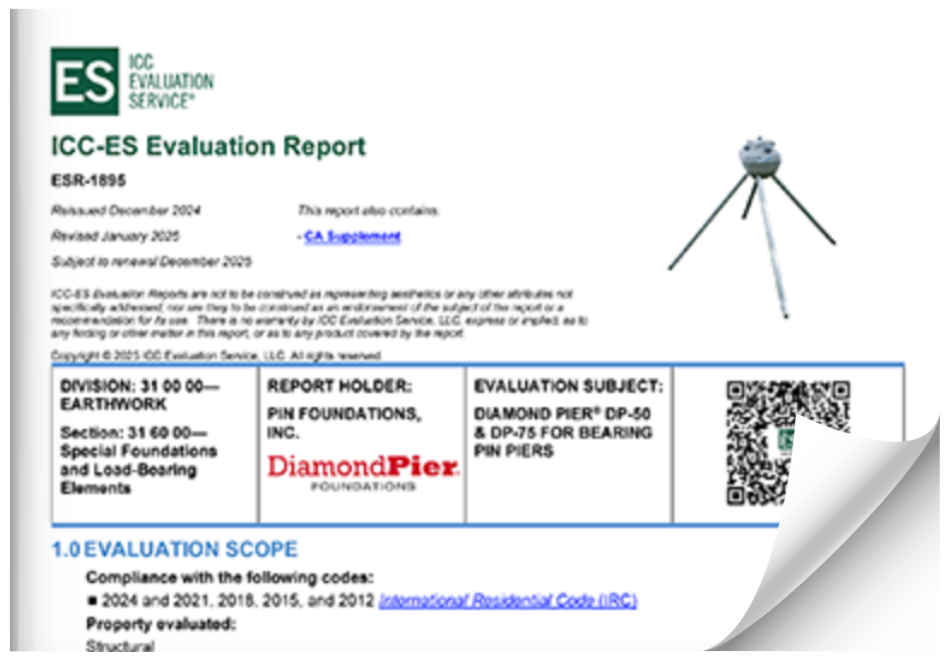Code Compliance for Diamond Pier Foundations Sold Through Retail Stores
NEW ESR-1895 REPORT
Updated! The newly revised ICC ESR 1895 provides improved guidance on Conditions of Use in regions where the frost line exceeds 12 inches. Section 5.3 now clearly refers code officials to the Diamond Pier Installation Manual for frost depth ratings!
Diamond Pier models DP-50/50", DP-75/50" & DP-75/63" are code compliant in municipalities that have adopted the International Residential Code - Versions 2006-2024. The EER-1895 Equivalency Evaluation Report (EER), addresses and determines the equivalency of the application of the Diamond Pier foundation, models DP50 & DP75, evaluated by ICC-ES, for compliance with the prescriptive requirements of the International Residential Code (IRC).
The EER-1895 Equivalency Evaluation Report (EER), addresses and determines the equivalency of the application of the Diamond Pier foundation, models DP50 & DP75, evaluated by ICC-ES, for compliance with the prescriptive requirements of the International Residential Code (IRC).
In the state of Wisconsin the Diamond Pier is governed by the Wisconsin Uniform Dwelling Code and has been reviewed under the Wisconsin Building Product Evaluation - Product Approval # 201612-O.
Most states are governed by a state code, but if you live in a state that does not have a state code, you should first inquire with the building department as to their published code. If the local town, city, or municipality has adopted the IRC, then the ICC-ES Evaluation Report ESR-1895 and EER-1895 for the DP-50 & DP-75 and the instructions below will apply.
Do not install the Diamond Pier footings until the building department has approved your plans. The building department is required to review your project, prior to use, to ensure the application of the Diamond Pier foundation meets the requirements of the Diamond Pier Installation Manual and the ESR-1895 and EER-1895 reports, and that the project loads do not exceed the limits of the Diamond Pier Load Chart. There may also be site-specific anomalies that will affect the use of the Diamond Pier product. The building department as the Authority Having Jurisdiction (AHJ) must ensure that the requirements listed above and that the intent of code have been met within the context of your site-specific project.
The path to code compliance for products purchased through retail stores depends on the type of project being supported by the Diamond Pier DP-50 & DP-75 models.
Documents You'll Need to Submit with Your Plans
For projects defined in paragraph 2.0 of the ESR-1895; as decks, covered decks, walkways, stairways, and accessory structures as defined by the IRC, or similar projects that meet this intent, submit to your local building code department:
- A copy of the ESR-1895 and the EER-1895
- A copy of the Diamond Pier Load Chart
- A copy of your building plans with Diamond Pier footings indicated and specified as the foundation of the project.
For Municipalities that have adopted the IRC:
Diamond Pier Foundations Sold Through Retail Stores
Diamond Pier foundations sold through retail stores are pre-engineered to a specific capacity for installation in soils with a minimum bearing capacity of 1500 psf. Currently products sold through retail stores are limited to:
DP-50/50”
DP-75/50”
DP-75/63”
The intended use for Diamond Pier DP-50 and DP-75 foundations sold through retail stores is to support simple residential projects constructed with columns, posts, and beams installed in minimum 1500 psf soils. Project loads are limited to the capacities defined in the “Residential Diamond Pier Load Chart” published by the manufacturer Pin Foundations, Inc. (PFI). The scope of project is defined as decks, covered decks, walkways, stairways, and accessory structures as defined in the International Residential Code (IRC), or similar projects that meet this intent. The DP-75 should be used for larger, more-complex structures, and the DP-50 for smaller, simpler projects.
Load Chart Uses & Applications Full Installation Manual
More Complex Projects
For projects that are defined as more complex than those defined in paragraph 2.0 of the ESR-1895, which iclude; decks, covered decks, walkways, stairways, and accessory structures as defined in the IRC, one of the following two paths may be satisfactory with the building department. Consult with your local building department regarding these additional paths to code compliance. They will inform you if any additional information needed.
- For projects that only require a review of bearing capacity, uplift, and lateral loads and that will be installed in soils meeting the 1500 psf minimum presumptive soil capacity, a registered design professional may submit a plan to the building department providing the Diamond Pier capacities and testing reports as evidence of equivalent or better performance when the required loads are within the limits of the published capacities of the Diamond Pier model being specified.
- For projects that require a review of asymmetrical, rotational, overturning, or dynamic forces, or where presumptive soil capacities cannot be determined, site-specific engineering is required. Please reference Commercial and Special-Order Project Services.

